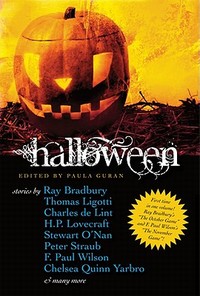 Edited By PAULA GURAN (Prime Books; 2011)
Edited By PAULA GURAN (Prime Books; 2011)
A selection of new and old stories make up HALLOWEEN, an anthology about, as the title portends, Halloween. Nearly all the tales are strong, and a few even qualify as great; it’s curious, then, that I found the overall book underwhelming. The problem may be with the subject matter, which doesn’t allow for much in the way of macabre invention, seeing as how Halloween is by its very nature all about scares.
Nearly all the tales are strong, and a few even qualify as great;
A lack of invention, in fact, is a common factor of these stories, whose conceptions include familiar conceits like a forbidding personage showing up on or around Halloween whose presence portends bad things (“The Halloween Man” by William F. Nolan, “Memories” by Peter Crowther), scary pumpkin-headed dudes (“Auntie Elspeth’s Halloween Story” by Esther M. Friesner, “Pumpkin Night” by Gary McMahon), supernaturally-endowed masks (“Mask Game” by John Shirley) and the old real-ghouls-turning-up-amid-the-costumed-ones gag (“Pranks” by Nina Kiriki Hoffman, “The Universal Soldier” by Charles de Lint). Even the normally reliable Thomas Ligotti’s contribution, “Conversations in A Dead Language,” about a lonely man who meets his maker on Halloween, is curiously flat and unimaginative.
Among the better entries is “Monsters” by Stuart O’Nan, about a young boy involved in a horrific accident whose brilliance is in its consistently unpredictable, reality-centered depiction of what befalls that boy, his friends and his family. Another standout is the novella-length “Pork Pie Hat” by Peter Straub, about a most horrific childhood memory related by an aging jazz maestro that showcases Straub’s talent for crafting vivid characterizations and hallucinatory horror to great effect (although the story, like quite a few other tales in this book, is readily available elsewhere). I also appreciated “Hornets” by Al Sarrantonio, an author who has made Halloween his own in an unnerving account of a tormented writer, his missing wife and an inexplicable hornet infestation.
I also appreciated “Hornets” by Al Sarrantonio, an author who has made Halloween his own in an unnerving account of a tormented writer, his missing wife and an inexplicable hornet infestation.
Further stand-outs include “On A Dark October,” a brief bit of unalloyed ugliness by Joe R. Lansdale that was apparently rejected for inclusion in the Twilight Zone Magazine for being too nasty, and “Tricks & Treat: One Night on Halloween Street” by Steve Resnic Tem, a collection of 12 brief Halloween-set vignettes marked by a distinct surreality that’s downright Kafkaesque. “On the Reef” by Caitlin R. Kiernan audaciously combines traditional Halloween iconography with that of the Cthulhu mythos of H.P. Lovecraft in its account of arcane rituals whose principal characters include a “Keeper of the Masks.”
“The October Game” is an oldie by Ray Bradbury, and an impressive exercise in subtle disquiet with a GREAT final line. Its inclusion here (though only in the print edition, as Bradbury refused to authorize the digital publication of his stories) is primarily so it can be paired with “The November Game,” F. Paul Wilson’s decades-after-the-fact sequel. It’s not nearly as good, with a highly affected prose style that tries, and fails, to ape the poetic sparseness of Bradbury’s original.
“The October Game” is an oldie by Ray Bradbury, and an impressive exercise in subtle disquiet with a GREAT final line.
Before concluding this review I’ll have to mention the introductions to the stories by editor Paula Guran, who for some reason lavishes copious attention on extraneous details. In her intro to the abovementioned Stuart O’Nan story, for instance, Guran delivers a lengthy diatribe on family and religion, even though those things constitute but a portion of the text, just as in her preamble to Sarah Langan’s “The Great Pumpkin Arrives At Last” Guran gives us the particulars on IT’S A GREAT PUMPKIN CHARLIE BROWN, which is mentioned in the story as playing on a TV in the background. If Guran’s aim was to get her readers thinking, or simply to call attention to herself, then she’s certainly succeeded.
